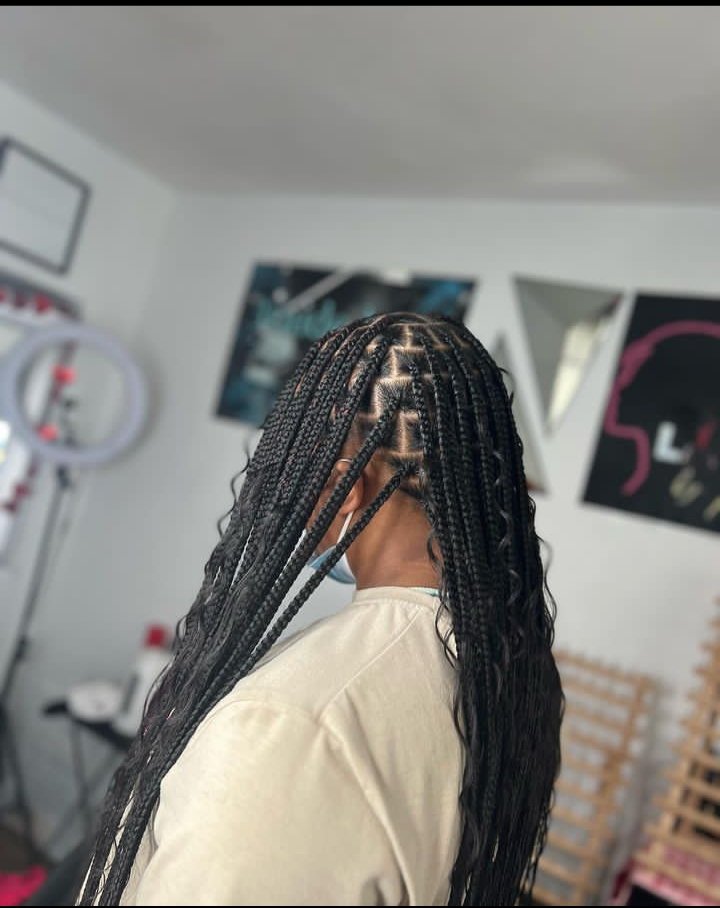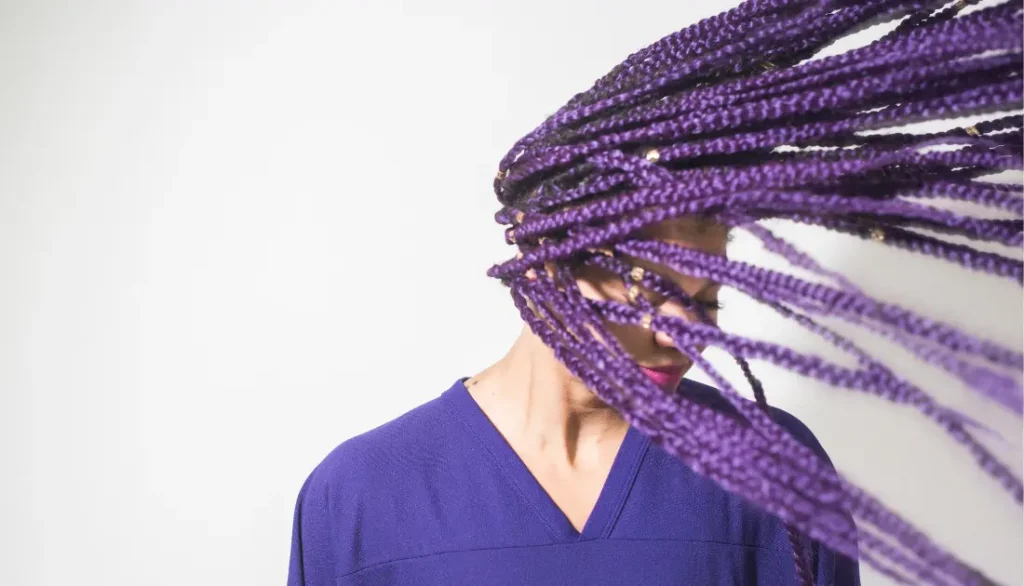Uncategorized
Knotless Vs Regular Braids: Which is Better?
Braids are an incredibly versatile hairstyle that can be worn in many different ways depending on your preference and lifestyle, you may choose to have your hair braided with either knotless or regular braiding techniques.
Both methods have their unique advantages and disadvantages, so it’s important to understand the differences between knotless and regular box braids before deciding which one is best for you.

Knotless braids are becoming increasingly popular due to their more natural, lightweight appearance and their ability to last longer without needing to be re-braided. Regular braids, on the other hand, require more maintenance and can be more uncomfortable to wear for extended periods. In this article, we’ll discuss the differences between knotless and regular braids and provide some helpful tips for choosing the right one for you.
Knotless Braids

Braided hairstyles are an iconic look, but what do you do when you want to switch up your style? The answer is knotless braids! Knotless braiding is a newer technique that offers an alternative to the traditional braiding style. It’s a great way to give yourself a unique and modern look. The difference between knotless and regular braids lies in the technique.
Knotless braids follow a feed-in technique where braiding hair extensions are consecutively fed in until the desired thickness is achieved. Knotless braids’ deserved popularity is attributed to their natural appearance and the almost painless installation process.
Knotless braids are the newer, more modern style of braiding. Unlike regular braids, knotless braids do not require any knots. Instead, the hair is divided into three sections and then crossed over each other in the same way as regular braids. However, the difference lies in the technique: rather than making a knot, the hair is woven together from the base of the scalp.
Installation of Knotless Braids
Washing and conditioning your hair will help you get ready. Since your hair will be in braids for a long time, it is important to prioritize the health of your hair. Cleaning up product buildup, dirt, and oils from your hair is a good first step, and you should then use a hydrating conditioner to give it the moisture it needs.
Let your hair dry completely. After giving your hair a good brushing to ensure that it has been sufficiently detangled, divide it into several tiny parts. To obtain a clean section, apply braiding gel as you go.
Grab a piece, then clip the remaining sections away to braid with ease. Prepare your hair bundles by splitting them into portions of the desired braid size. Split the chosen hairpiece into three sections, then start braiding after about two inches. After that, add a braiding hair extension following the size, length, and thickness you want, and keep adding braiding hair until the desired outcome is attained.
Tie an elastic band across each braid. When you’re finished, apply a braid sealer or dip the ends of the braids in hot water to seal them. After braiding your hair, generously coat your braids in a hair mousse.
Pros of Knotless Braids
Knotless braids offer several benefits over regular braids. These include:
- Knotless box braids are less painful than traditional box braids, put less tension on your scalp, and cause less product build-up.
- Due to the less tension placed on the scalp, there is an increased amount of comfort and a decreased chance of traction alopecia – hair loss brought by excessive pressure to the scalp and hair, thinning edges, and not to mention the absence of headaches.
- They are simpler to maintain and style. The absence of knots makes the braids less prone to unraveling or getting twisted.
- A style that protects: Knotless braids are wonderful for keeping you looking sharp and also act as a barrier from the elements.
- Versatility: From cornrows to box braids, a range of various hairstyles may be made using knotless braiding techniques. As the hair is braided together from the scalp rather than twisted into a knot, they also offer a more natural appearance.
- Knotless braids, in contrast to traditional box braids, lay flat on your head and move more freely because there is no knot at the base.
Cons of Knotless Braids
- Time-consuming: Since knotless braids require more braiding than conventional braids, installing them takes longer. The length of time required for this can be frustrating for people with demanding schedules.
- Cost: Because knotless braids require more braiding than conventional braids, they are more expensive. Knotless braid installation can cost more since it takes more time and effort.
Regular Box Braids

The classic braids that most of us are accustomed to are regular braids. They are also known as knot braids since they involve an anchor knot rather than knotless braids. The knotless braid technique has rapidly supplanted conventional braids, although many natural hair aficionados contend that standard braids still work best for them due to factors like the non-scalpy appearance and versatility.
The regular box braids which are strongly rooted in African ancestry have a timeless appeal, and the knots at the roots are a thing for many.
Installation of Regular Box Braids
Wash and condition the hair, making sure it is completely dry and free of any tangles or knots. Section the hair into your braid patterns ranging from boxy, diamond, triangle, puzzle part to a spider web, and use the comb and hair clippers to create a clean line.
Start by selecting a section of hair and separating it into three equal parts. Prep the hair extensions and take your preferred size, fold them in half, and place them in the middle section. Then cross the right section over the middle section and then cross the left section over the right section. Repeat this process until you reach the end of the hair. Repeat this process for each section of hair until all sections have been braided.
Pros of Regular Box Braids
- Regular braids are more stable since the knot at the scalp’s base aids in maintaining the braid’s position.
- Due to the simpler technique and fewer processes required, they are also simpler to produce and maintain.
- Regular braids are low maintenance because all that is required to keep them at their best is normal cleaning and moisturizing, sleeping with a protective head wrap, and braid mousse or spray.
- Box braids are a protective style that tries to protect natural hair from elements including excessive physical manipulation, weather, and humid environments that can harm the hair.
Cons of Regular Box Braids
- The knot in regular braids can create strain and breakage in the hair. This is because there is direct pressure being applied to the scalp, and traction alopecia and thinning margins might result if it is done too tightly. You must avoid braids that are excessively tight and communicate your position to your hairdresser.
- Installing regular Box braids takes time and skill, and it can take several hours.
- Because the braids are frequently tight or close to the scalp, they might irritate or itch some people.
So Which is Best for Your Hair?
Knotless braids are a newer type of braiding technique that has gained popularity in recent years. Unlike traditional braids, knotless braids are created by gradually adding hair to the braid, rather than knotting it at the root. This technique results in a more natural-looking braid that is less likely to cause tension and damage to the hairline. Additionally, knotless braids tend to be lighter and more comfortable to wear than regular braids.
Knotless braids can also last longer than traditional braids when done correctly. This is because the lack of knots means there is less tension on the hair, resulting in less pulling and breakage. However, it’s important to note that the lifespan of braids depends on various factors, including the size of the braids, the type of hair used, and how well the hair is cared for during the braiding period.
Regular braids, on the other hand, are the traditional braiding method where the hair is knotted at the root. This style can be more affordable and quicker to install than knotless braids, and it can work well for those with thicker hair. However, regular braids can be more damaging to the hairline due to the tension caused by the knots, and they may not look as natural as knotless braids.
Making a choice between knotless and regular braids boils down to your personal preference and hair type. Knotless braids is a better option if you’re looking for a more natural and less damaging style while regular braids is a great choice if you have thicker hair and a tight budget. Regardless of the type of braids you choose, the most important thing to keep in mind is proper hair care during and after the braiding period.
Conclusion
While ordinary box braids and knotless braids serve comparable purposes and serve similar functions, their differences come from how they are installed. If you’re having trouble deciding, try both and stay with what seems right to you.


